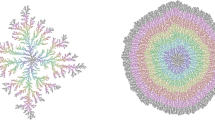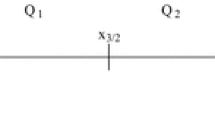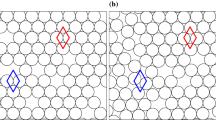Abstract
We consider the percolation model with nucleation and simultaneous growth of multiple finite clusters, taking the initial seed concentration \(\rho \) as a tunable parameter. Growing objects expand with constant speed, filling the nodes of the triangular lattice according to rules that control their shape. As growing objects of predefined shape, we consider needle-like objects and “wrapping” objects whose size is gradually increased by wrapping the walks in several different ways, making triangles, rhombuses, and hexagons. Growing random walk chains are also analyzed as an example of objects whose shape is formed randomly during the growth. We compare the percolation properties and jamming densities of the systems of various growing shapes for a wide range of initial seed densities \(\rho < 0.5\). To gain a basic insight into the structure of the jammed states, we consider the size distribution of deposited growing objects. The presence of the most numerous and the largest growing objects is recorded for the system in the jamming state. Our results suggest that at sufficiently low seed densities \(\rho \), the way of the object growth has a substantial influence on the percolation threshold. This influence weakens with increasing \(\rho \) and ceases near the value of the site percolation threshold for monomers on the triangular lattice, \(\rho _\text {p}^* = 0.5\).
Graphical Abstract













Similar content being viewed by others
Data Availability
This manuscript has no associated data or the data will not be deposited. [Authors’ comment: This is a theoretical study and there are no experimental data.]
References
Dietrich Stauffer, Antonio Coniglio, and Mireille Adam, Gelation and critical phenomena,in Polymer Networks, edited by Karel Dušek (Springer Berlin Heidelberg, Berlin, Heidelberg, 1982) pp. 103–158
Paul Meakin, The growth of rough surfaces and interfaces. Phys. Rep. 235, 189–289 (1993). https://doi.org/10.1016/0370-1573(93)90047-H
D. Stauffer, A. Aharony, Introduction to percolation theory (Taylor & Francis, London, 1994)
W. Lebrecht, P.M. Centres, A.J. Ramirez-Pastor, Analytical approximation of the site percolation thresholds for monomers and dimers on two-dimensional lattices. Physica A 516, 133–143 (2019). https://doi.org/10.1016/j.physa.2018.10.023
Grzegorz Kondrat, Impact of composition of extended objects on percolation on a lattice. Phys Rev E 78, 011101 (2008). https://doi.org/10.1103/PhysRevE.78.011101
V. Cornette, A.J. Ramirez-Pastor, F. Nieto, Dependence of the percolation threshold on the size of the percolating species, Physica A: Statistical Mechanics and its Applications327, 71–75 (2003). proceedings of the XIIIth Conference on Nonequilibrium Statistical Mechanics and Nonlinear Physics. https://doi.org/10.1016/S0378-4371(03)00453-9
Lj. Budinski-Petković, I. Lončarević, M. Petković, Z.M. Jakšić, S.B. Vrhovac, Percolation in random sequential adsorption of extended objects on a triangular lattice. Phys Rev E 85, 061117 (2012). https://doi.org/10.1103/PhysRevE.85.061117
D. Dujak, A. Karač, Lj. Budinski-Petković, I. I Lončarević, Z. M. Jakšić, S. B. Vrhovac, Percolation in random sequential adsorption of mixtures on a triangular lattice. J Stat Mech 2019, 113210 (2019). https://doi.org/10.1088/1742-5468/ab4588
J.W. Evans, Random and cooperative sequential adsorption. Rev Mod Phys 65, 1281–1329 (1993). https://doi.org/10.1103/RevModPhys.65.1281
Vladimir Privman, Dynamics of nonequilibrium deposition. Colloids and Surfaces A: Physicochemical and Engineering Aspects 165, 231–240 (2000). https://doi.org/10.1016/S0927-7757(99)00412-4
J. Talbot, G. Tarjus, P.R. Van Tassel, P. Viot, From car parking to protein adsorption: an overview of sequential adsorption processes. Colloids and Surfaces A: Physicochemical and Engineering Aspects 165, 287–324 (2000). https://doi.org/10.1016/S0927-7757(99)00409-4
A. Cadilhe, N.A.M. Araújo, V. Privman, Random sequential adsorption: from continuum to lattice and pre-patterned substrates. J Phys 19, 065124 (2007). https://doi.org/10.1088/0953-8984/19/6/065124
V. Cornette, A.J. Ramirez-Pastor, F. Nieto, Percolation of polyatomic species on a square lattice. Euro Phys J B Condensed Matter Complex Syst 36, 391–399 (2003). https://doi.org/10.1140/epjb/e2003-00358-1
N. Vandewalle, S. Galam, M. Kramer, A new universality for random sequential deposition of needles. Euro Phys J B 14, 407–410 (2000). https://doi.org/10.1007/s100510051047
Grzegorz Kondrat, Andrzej Pȩkalski, Percolation and jamming in random sequential adsorption of linear segments on a square lattice. Phys Rev E 63, 051108 (2001). https://doi.org/10.1103/PhysRevE.63.051108
Grzegorz Kondrat, Zbigniew Koza, Piotr Brzeski, Jammed systems of oriented needles always percolate on square lattices. Phys Rev E 96, 022154 (2017). https://doi.org/10.1103/PhysRevE.96.022154
M.G. Slutskii, LYu. Barash, YuYu. Tarasevich, Percolation and jamming of random sequential adsorption samples of large linear \(k\)-mers on a square lattice. Phys Rev E 98, 062130 (2018). https://doi.org/10.1103/PhysRevE.98.062130
Federica Rampf, Ezequiel V. Albano, Interplay between jamming and percolation upon random sequential adsorption of competing dimers and monomers. Phys Rev E 66, 061106 (2002). https://doi.org/10.1103/PhysRevE.66.061106
Piotr Adamczyk, Piotr Romiszowski, Andrzej Sikorski, A simple model of stiff and flexible polymer chain adsorption: the influence of the internal chain architecture. J Chem Phys 128, 154911 (2008). https://doi.org/10.1063/1.2907715
Grzegorz Kondrat, Influence of temperature on percolation in a simple model of flexible chains adsorption. J Chem Phys 117, 6662–6666 (2002). https://doi.org/10.1063/1.1505866
P. Longone, P.M. Centres, A.J. Ramirez-Pastor, Percolation of aligned rigid rods on two-dimensional square lattices. Phys Rev E 85, 011108 (2012). https://doi.org/10.1103/PhysRevE.85.011108
E.J. Perino, D.A. Matoz-Fernandez, P.M. Pasinetti, A.J. Ramirez-Pastor, Jamming and percolation in random sequential adsorption of straight rigid rods on a two-dimensional triangular lattice. J Stat Mech 2017, 073206 (2017). https://doi.org/10.1088/1742-5468/aa79ae
Joan Adler, Bootstrap percolation. Physica A 171, 453–470 (1991). https://doi.org/10.1016/0378-4371(91)90295-N
S.R. Broadbent, J.M. Hammersley, Percolation processes. I: crystals and mazes. Math. Proc. Cambridge Philosophical Soc. 53, 629–641 (1957). https://doi.org/10.1017/S0305004100032680
S.B. Santrs, I. Bose, Spiral site percolation on the square and triangular lattices. J. Phys. 25, 1105–1118 (1992). https://doi.org/10.1088/0305-4470/25/5/018
Babak Nikoobakht, Mostafa A. El-Sayed, Preparation and growth mechanism of gold nanorods (nrs) using seed-mediated growth method. Chem. Materials 15, 1957–1962 (2003). https://doi.org/10.1021/cm020732l
Anand Gole, Catherine J. Murphy, Seed-mediated synthesis of gold nanorods: role of the size and nature of the seed. Chem. Materials 16, 3633–3640 (2004). https://doi.org/10.1021/cm0492336
Susan E. Habas, Hyunjoo Lee, Velimir Radmilovic, Gabor A. Somorjai, Peidong Yang, Shaping binary metal nanocrystals through epitaxial seeded growth. Nat. Materials 6, 692–697 (2007). https://doi.org/10.1038/nmat1957
Samuel E. Lohse, The quest for shape control: a history of gold nanorod synthesis. Chem. Materials 25, 1250–1261 (2013). https://doi.org/10.1021/cm303708p
Younan Xia, Kyle D. Gilroy, Hsin-Chieh. Peng, Xiaohu Xia, Seed-mediated growth of colloidal metal nanocrystals. Angewandte Chemie Int. Ed. 56, 60–95 (2017). https://doi.org/10.1002/anie.201604731
Bappaditya Roy, S.B. Santra, First-order transition in a percolation model with nucleation and preferential growth. Phys. Rev. E 95, 010101 (2017). https://doi.org/10.1103/PhysRevE.95.010101
Bappaditya Roy, S.B. Santra, Finite size scaling study of a two parameter percolation model: constant and correlated growth. Physica A 492, 969–979 (2018). https://doi.org/10.1016/j.physa.2017.11.028
J. Carrey, J.-L. Maurice, Transition from droplet growth to percolation: Monte carlo simulations and an analytical model. Phys. Rev. B 63, 245408 (2001). https://doi.org/10.1103/PhysRevB.63.245408
I. Lončarević, Lj. Budinski-Petković, D. Dujak, A. Karač, Z. M. Jakšić, and S. B. Vrhovac, The study of percolation with the presence of extended impurities, Journal of Statistical Mechanics: Theory and Experiment2017, 093202 (2017). http://stacks.iop.org/1742-5468/2017/i=9/a=093202
M.E.J. Newman, R.M. Ziff, Fast Monte Carlo algorithm for site or bond percolation. Phys. Rev. E 64, 016706 (2001). https://doi.org/10.1103/PhysRevE.64.016706
I. Lončarević, Lj. Budinski-Petković, S.B. Vrhovac, Simulation study of random sequential adsorption of mixtures on a triangular lattice. Euro. Phys. J. E. 24, 19–26 (2007). https://doi.org/10.1140/epje/i2007-10206-4
Lj. Budinski-Petković, S.B. Vrhovac, I. Lončarević, Random sequential adsorption of polydisperse mixtures on discrete substrates. Phys. Rev. E 78, 061603 (2008). https://doi.org/10.1103/PhysRevE.78.061603
Lj Budinski-Petković, I Lončarević, Z M Jakšić, and S B Vrhovac, Jamming and percolation in random sequential adsorption of extended objects on a triangular lattice with quenched impurities, Journal of Statistical Mechanics: Theory and Experiment2016, 053101 (2016). http://stacks.iop.org/1742-5468/2016/i=5/a=053101
H. Markus Porto, Eduardo Roman, Critical packing fraction of rectangular particles on the square lattice. Phys. Rev. E 62, 100–102 (2000). https://doi.org/10.1103/PhysRevE.62.100
Mitsunobu Nakamura, Percolational and fractal property of random sequential packing patterns in square cellular structures. Phys. Rev. A 36, 2384–2388 (1987). https://doi.org/10.1103/PhysRevA.36.2384
Acknowledgements
This work was supported by the Ministry of Education, Science, and Technological Development of the Republic of Serbia. Numerical simulations were run on the PARADOX supercomputing facility at the Scientific Computing Laboratory of the Institute of Physics Belgrade.
Author information
Authors and Affiliations
Contributions
Study conception and design: S. B. Vrhovac and Lj. Budinski-Petković; Analysis and interpretation of numerical data: D. Dujak, A. Karač and Z. M. Jakšić; Development of the numerical simulations: D. Dujak and A. Karač; Drafting of manuscript: S. B. Vrhovac and Lj. Budinski-Petković; Critical revision: S. B. Vrhovac, Lj. Budinski-Petković and Z. M. Jakšić
Corresponding author
Rights and permissions
Springer Nature or its licensor holds exclusive rights to this article under a publishing agreement with the author(s) or other rightsholder(s); author self-archiving of the accepted manuscript version of this article is solely governed by the terms of such publishing agreement and applicable law.
About this article
Cite this article
Dujak, D., Karač, A., Budinski-Petković, L. et al. Percolation and jamming properties in particle shape-controlled seeded growth model. Eur. Phys. J. B 95, 143 (2022). https://doi.org/10.1140/epjb/s10051-022-00401-1
Received:
Accepted:
Published:
DOI: https://doi.org/10.1140/epjb/s10051-022-00401-1




